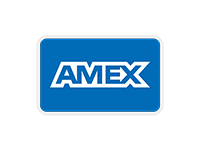Toronto's First Subway
(G-Class Subway Cars)
by Rob Lubinski
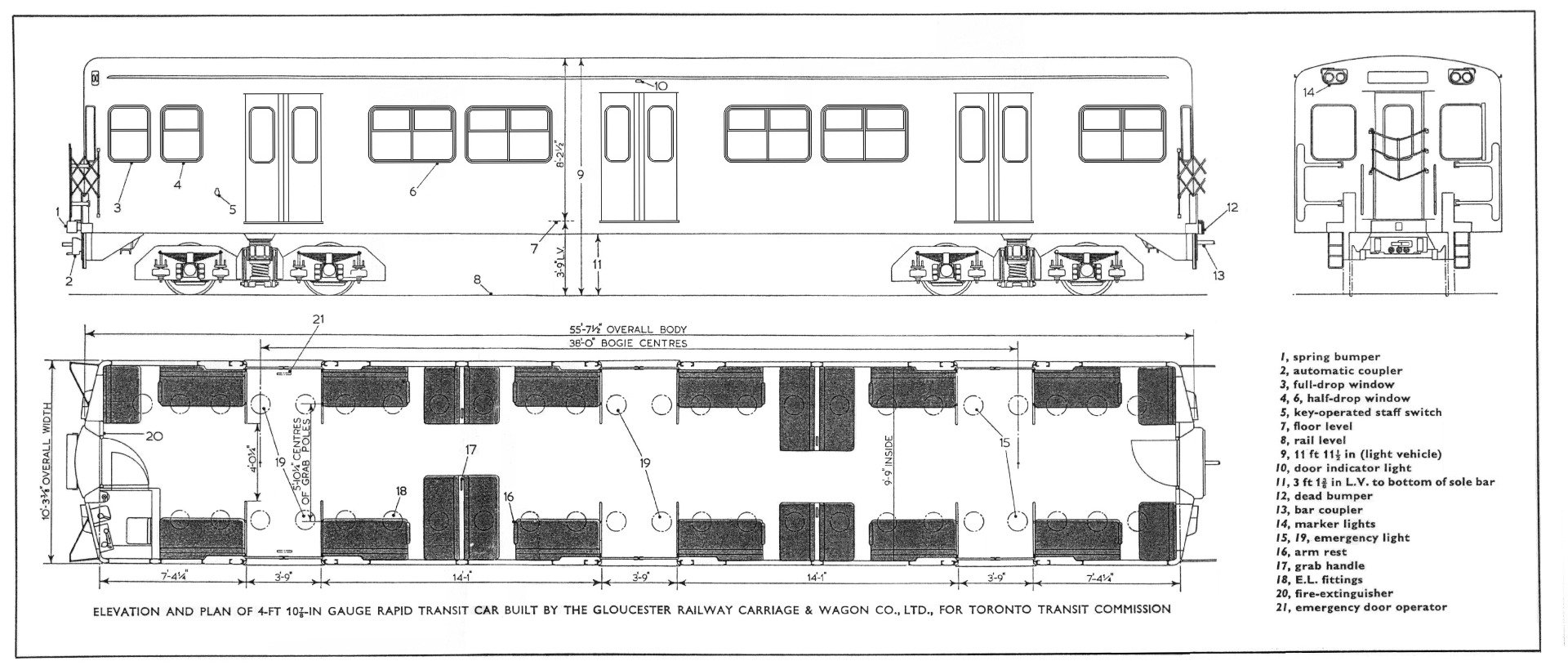
The general layout of G-1 class subway cars
The first proposals for underground rapid transit in Toronto date back to the early 20th Century. Due to the high cost of these plans, they were repeatedly rejected and nothing came of them. When the Toronto Transportation Commission (TTC) assumed responsibility for public transit within the City of Toronto in 1921 it set about modernizing the streetcar system and increasing service to new districts. The Great Depression put off any further thought of underground rapid transit, and the Second World War taxed the system with heavy ridership. The TTC began to look beyond the end of the war and in 1942 drafted its first rapid transit proposal, which would see streetcars operating in tunnels under Yonge and Queen Streets through the downtown area, and then branching out to separate routes beyond the tunnels, similar to the system in Boston. The TTC then engaged Charles DeLeuw, a noted transportation engineer from Chicago to further develop rapid transit plans, and in 1945 the TTC presented an updated plan which featured a dedicated subway line under Yonge St. and a streetcar rapid transit line under Queen St.
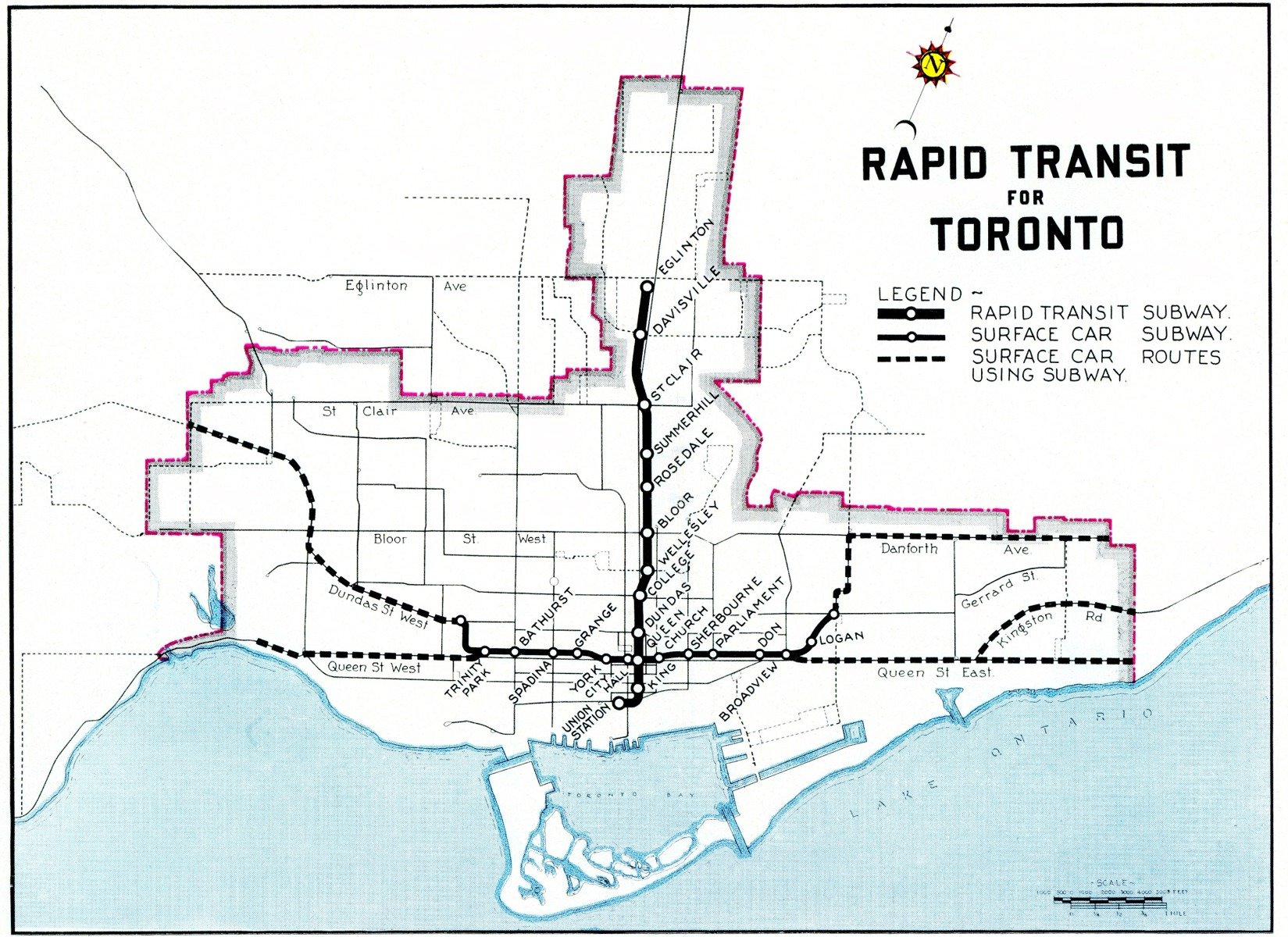
The TTC’s 1945 rapid transit proposal
Since the Yonge subway was new and not constrained by any existing infrastructure, DeLeuw proposed that the rapid transit cars should be close in width to railway passenger coaches to maximize passenger capacity (11 feet 4 inches wide) and trains would be up to 500 feet in total length. The first concepts for subway cars were based on the highly successful Presidents’ Conference Committee (PCC) streetcars, which were modern and faster than older conventional cars. The PCC-derived rapid transit car would utilize the traction system of the streetcars, with a lightweight subway car-styled body 48 feet in length. Conventional subway cars of the era were large heavy steel-bodied cars that resembled railway coaches. The first version of PCC rapid transit cars began operating in Chicago following the war.
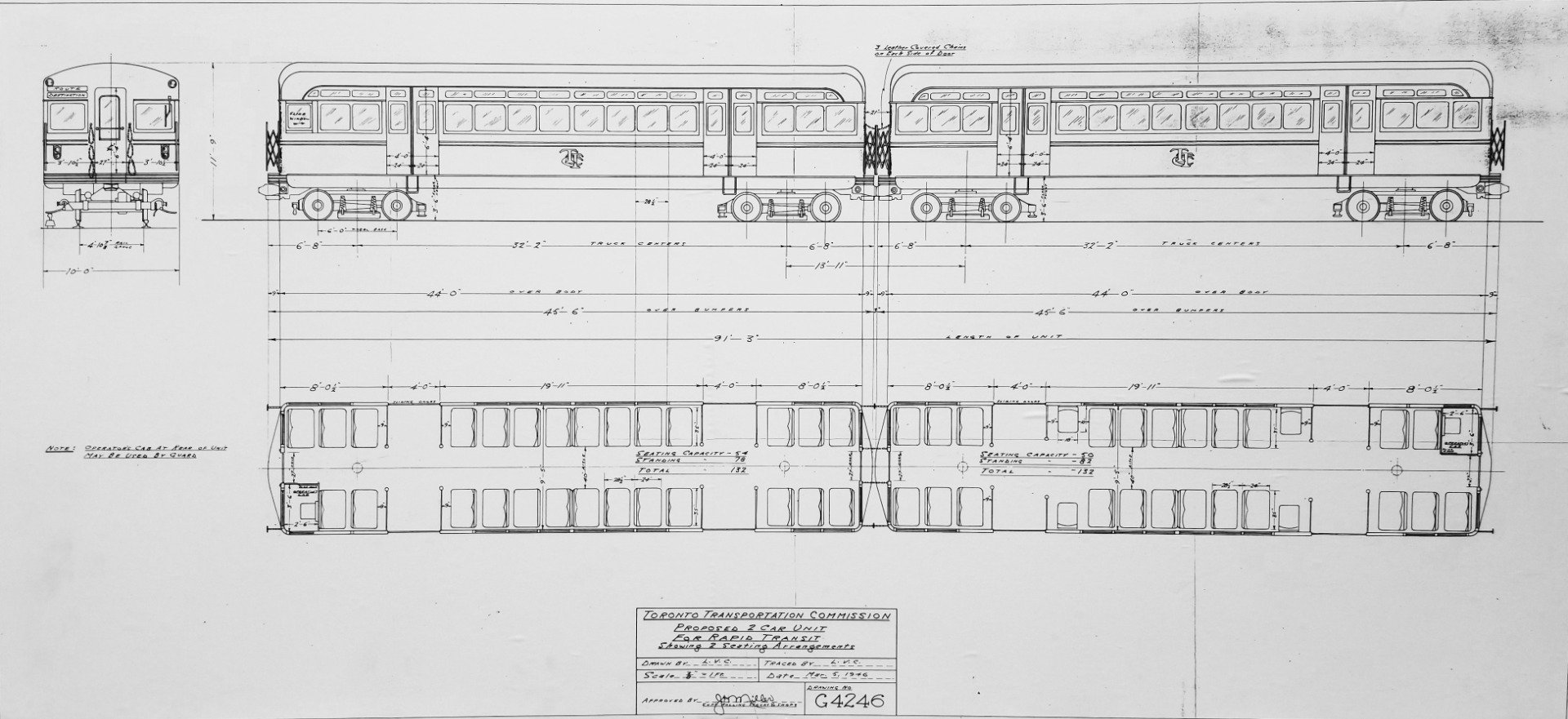
Early drawings of the TTC’s proposed rapid transit cars bore a strong resemblance to the PCC elevated cars that eventually operated in Chicago.
The Yonge Subway was approved by ratepayers in 1946 and construction commenced on September 8, 1949. By 1951, the TTC was ready to order cars for the subway. The body design had been updated with larger windows and a revised seating layout and no longer resembled a squared-off PCC streetcar. The cars would be painted red, with yellow-gold striping below the roofline and below the windows. In late 1949 the TTC built a full-size mock-up at its Hillcrest Shops to evaluate the layout of the car along with testing materials and colours. On February 20, 1951 the TTC requested bids for this type of car, and two bidders, Canadian Car & Foundry Ltd. and St. Louis Car Co., both submitted compliant bids however the TTC felt that the cost was exorbitant. After unsuccessfully trying to get the two bidders to reduce their costs substantially or come to an agreement to jointly build the cars, the TTC looked overseas. TTC representatives visited builders in the UK and Europe and were impressed by what they saw. The TTC then invited the overseas builders to bid along with the North American builders. Due to material restrictions resulting from the Korean War, the North American builders could not commit to being able to build the cars to meet the TTC’s expected subway completion target for the end of 1953. TTC management turned to the UK bidders, who were boosted by a guarantee from the UK government that it would make all efforts to ensure that materials would be available to build the cars if the TTC selected a UK-based builder.
Eight builders submitted bids with 20 alternative variations – most were compliant with the specified PCC rapid transit cars however one proposal from Gloucester Railway Carriage & Wagon Co. caught the attention of the TTC’s General Manager, W.E.P. Duncan. Gloucester proposed a longer steel-bodied car at 57 feet long which would mean only eight cars were needed for a full-length train instead of 10 48-foot cars. Fewer cars meant less equipment and lower capital and operating costs. Duncan recommended the selection of this proposal and on November 20, 1951 the TTC awarded a contract for 104 57-foot rapid transit cars to Gloucester for delivery by the end of 1953. The subway cars would be assigned fleet numbers beginning at #5000.
Gloucester’s engineers were unfamiliar with the PCC-type equipment specified. They did not have access to the PCC truck and traction technology, so they were challenged in how to produce a lightweight PCC-type car with different equipment. Construction of the cars immediately fell behind schedule and by the spring of 1953 TTC Chairman William C. McBrien personally wrote to Gloucester’s management and indicated that any delay in opening the subway resulting from the late delivery of the subway cars would be a great embarrassment to Gloucester and the TTC (and by extension to him). Gloucester immediately called a meeting of its suppliers to commit to timely delivery of needed components and its drawing team worked feverishly to make the car design work. Ultimately Gloucester substituted controls, trucks and other equipment with that had been most recently applied to London Underground R stock. The TTC’s representatives were aware of and approved these substitutions. Proposed outside-hung sliding doors presented another difficulty and were changed to doors which opened into pockets in the side of the car. The ventilation system proved to be another hurdle, with a large duct system needed to provide the desired volume of air flow. The substitutions and changes were happening at a rapid pace, and no one at Gloucester or the TTC tracked in detail the impact of these changes on the car weight, as the overriding priority was to get the first cars built in time for the 1953 CNE. The result was that the first two cars were about 25,000 lbs heavier than the design specifications. The expectation was a 60,000 lb car, the reality was a shocking 85,000 lb car. After getting over their surprise and dismay, Gloucester and the TTC immediately worked on remedial weight reductions, which shaved about 2,000 lbs from the car weight by the time thirty cars were built. Fortunately the traction and braking systems had the capacity to handle a much heavier weight however performance would be impacted as the trains would be slower to accelerate and harder on the brakes. The TTC was “disappointed” with the overweight, but the priority was to get the cars built in time for the subway opening, now expected in early 1954. There was no time to revisit specifications, order new components or re-evaluate the design of the car, which may have been unrealistic in its weight estimate.
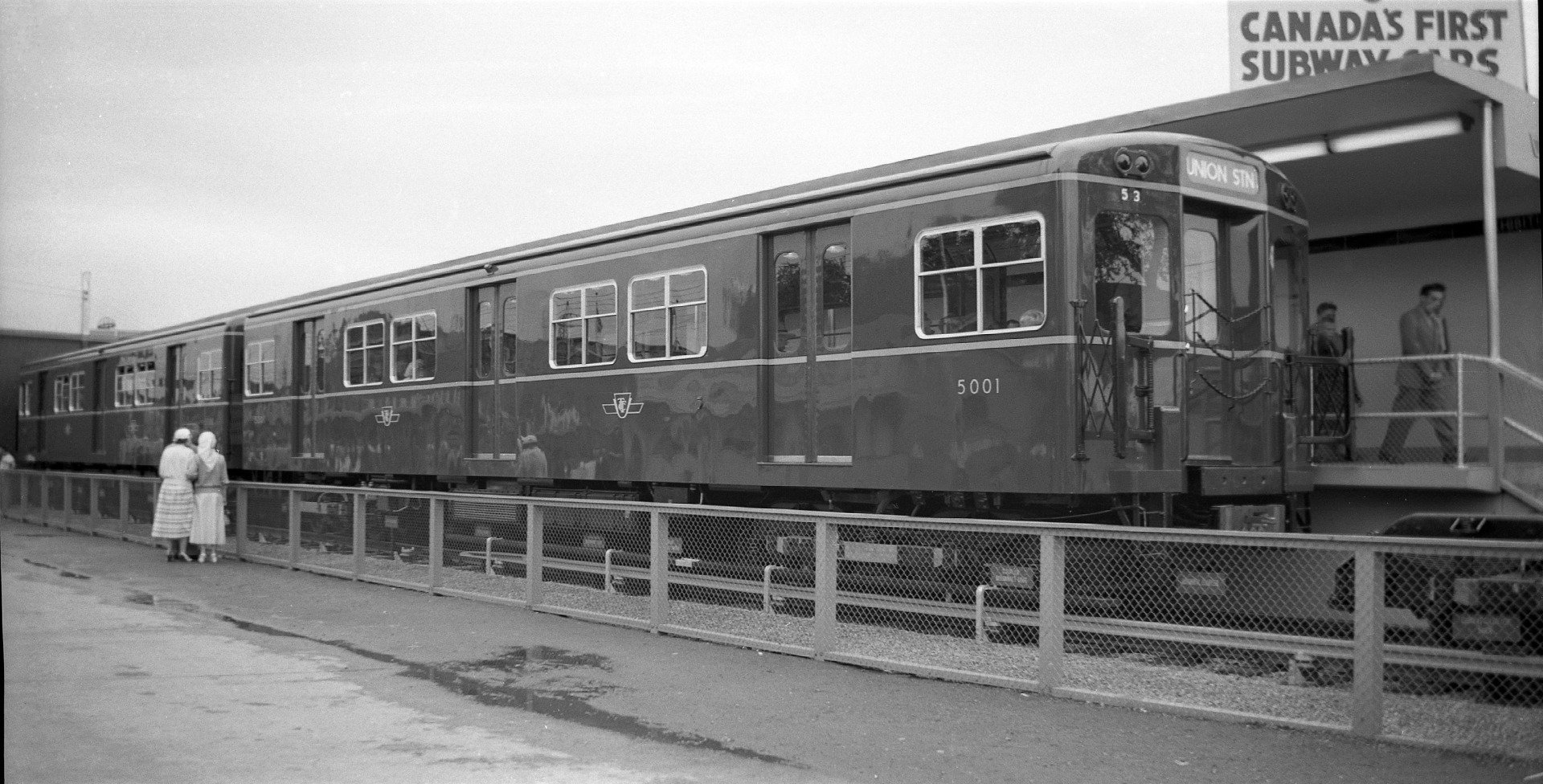
Cars 5000-5001 were displayed at the 1953 CNE with a mock-up of a station platform.

Cars 5004-5005 are loaded on flat cars in Montreal, ready for shipping to Toronto. Unknown photographer, RL collection.
The first two cars were delivered to the TTC on July 30, 1953 and were put on display at the CNE as part of a subway preview exhibit. The exhibit was popular and public interest in the subway was very high. After the CNE ended the two cars were towed by Peter Witt streetcars to the Davisville Yard on modified Brill streetcar trucks. By this time car deliveries became more frequent and Gloucester was able to get 100 cars finished and shipped by the end of January 1954. The cars were shipped by rail from whatever port they arrived at directly to the Davisville subway yard via the Belt Line Railway. This made testing and commissioning of the cars easier as they were unloaded directly onto the subway rails.
The specifications of the last four cars of the order were changed to aluminum bodies as part of an effort to promote the use of aluminum in railcar construction by the Aluminium Development Association in the UK. Two additional cars were later ordered to allow a six-car train of aluminum cars to be operated. These cars became the G-2 class, numbered #5100-#5105, (with the 100 steel cars designated as the G-1 class, numbered #5000-#5099) and were sometimes known as “white Gloucesters”. One of the two additional cars, #5104, carried a small plaque to commemorate the inspection of the cars by Her Majesty Queen Elizabeth II at the Gloucester plant on May 3, 1955. Power consumption was measured on the G-2 class train and compared against a train of the G-1 class and not surprisingly the results showed that the aluminum-bodied cars consumed less energy than their steel-bodied counterparts.
The Gloucester cars were designed to operate in married pairs, where the even-numbered car carried the motor-generator (M-G) set for battery charging and low-voltage systems, and the odd-numbered car carried the air compressor and coupling controls. The G class pairs could only couple even-to-odd numbers and had to be kept facing the same direction throughout their lives. Even numbered cars always faced the north end of the Davisville Yard and odd numbered cars always faced the south end. Each car had a spring-loaded bumper at one end and a static bumper at the other end. The spring-loaded bumper would push against the static bumper to reduce horizontal sway when the trains were running. The G class cars were the only TTC subway cars to have these specific requirements for their operation.
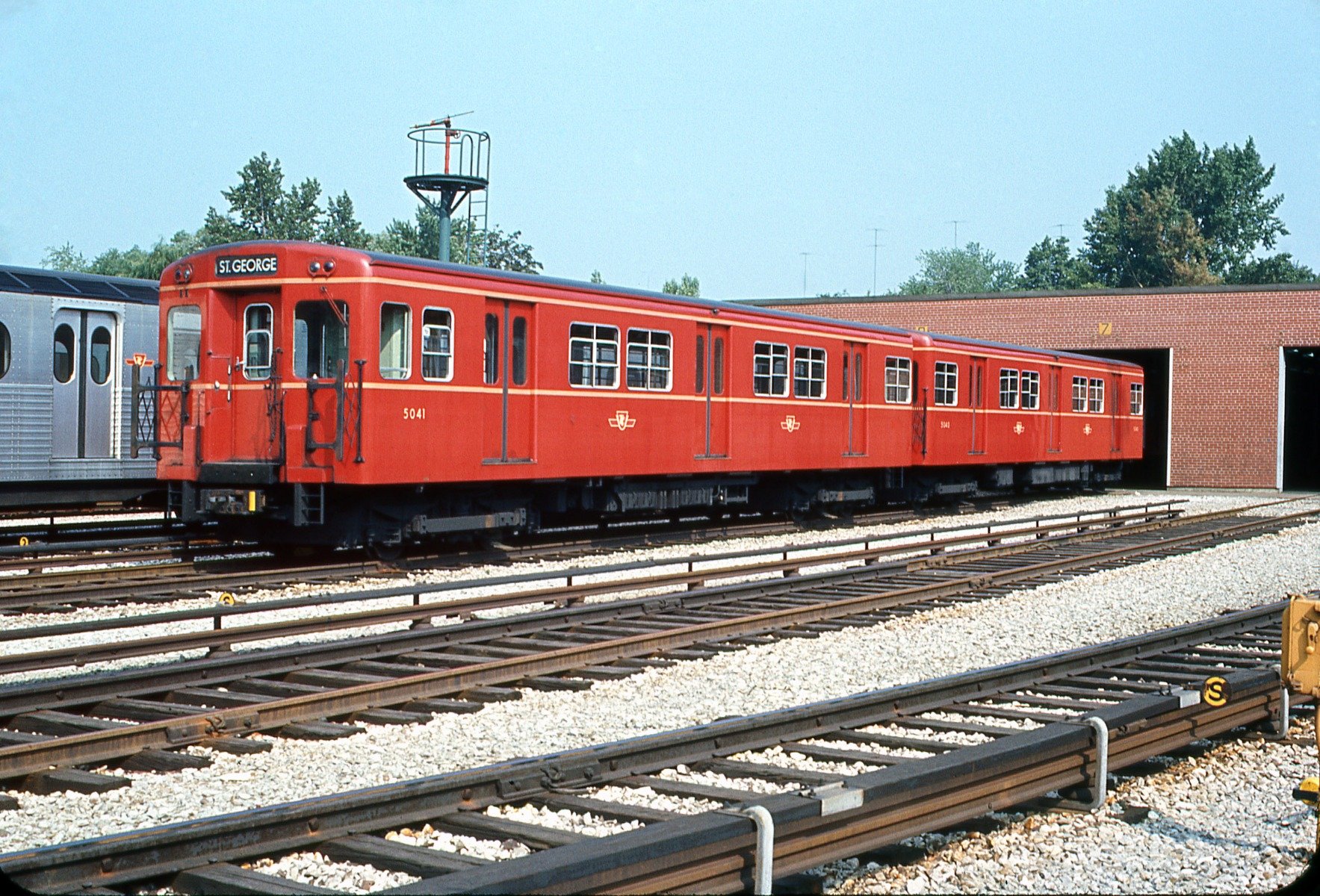
G-1 class cars 5041-5040 at the Davisville Yard on July 24, 1964. Bill Hood photo, RL Collection.
Canada’s First Subway opened on March 30, 1954 with great fanfare and was an instant success. Ridership exceeded expectations only a year after opening and in July 1955 the TTC ordered an additional 34 cars to increase capacity by operating service with eight-car trains instead of six-car trains. The 34 supplemental cars were to be built without operating controls (but still had cabs for use by guards) and inserted between pairs of the G-1 cars. These cars were designated the G-3 class (originally to be #5200-#5233) and featured steel bodies with aluminum roofs to reduce weight.
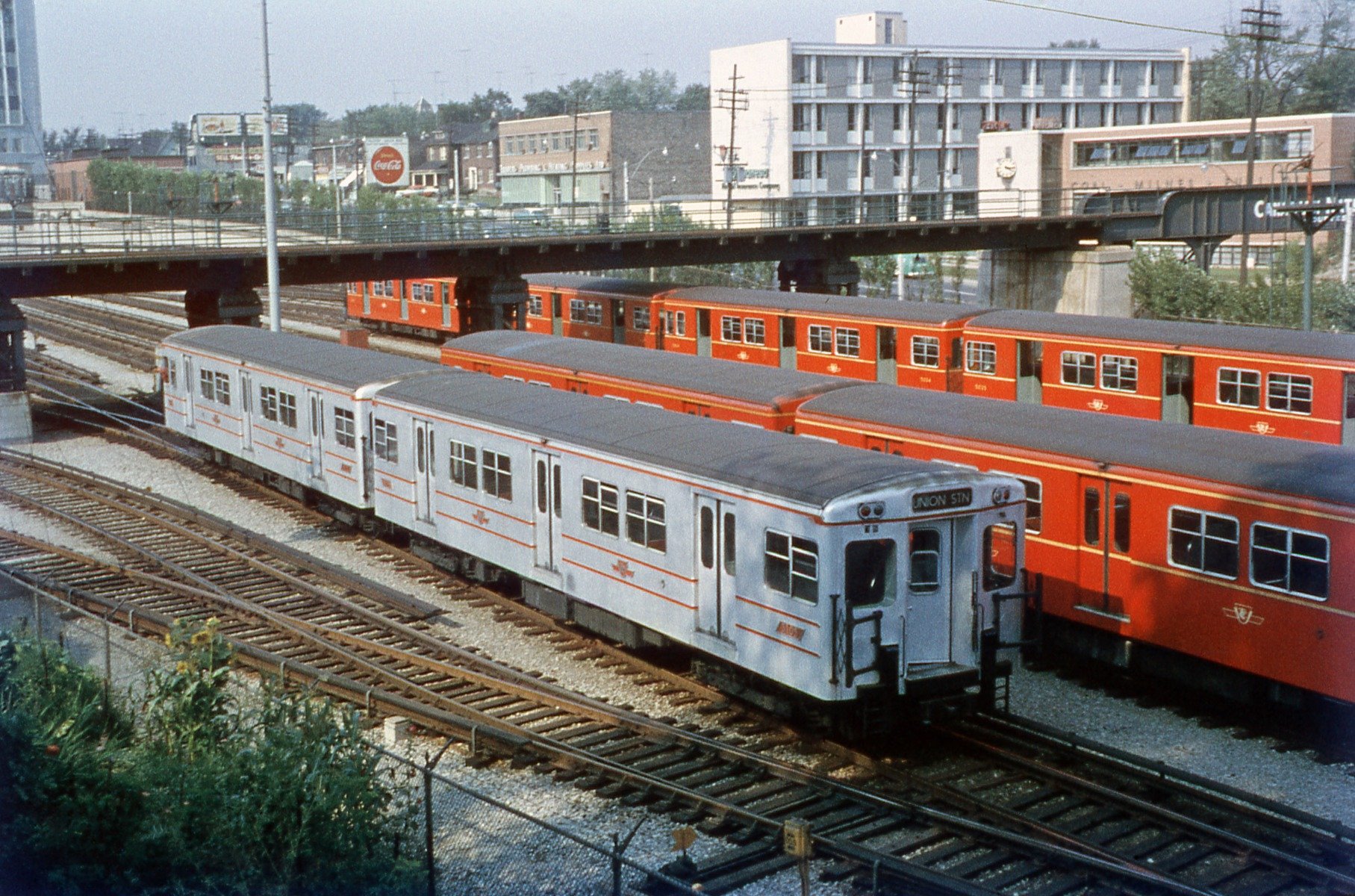
G-2 class cars 5105-5104 at the Davisville Yard on September 1, 1958. Unknown photographer, RL Collection.
The TTC was still interested in advancing subway technology and changed the specifications of the last six of the G-3 cars to include dynamic braking, which was used in PCC traction technology, but was not part of the original subway car order. Other experimental equipment was installed in the six cars, including more powerful traction motors, alternative gear boxes and suspension. The delivery of these cars coincided with the launch of the Sputnik spacecraft in 1958, so that they were nicknamed the “Sputnik” cars. They were designated as the G-4 class and operated as a standalone six-car train with two driving cars and four non-driving motor cars. These cars were also numbered into their own series, #5110-#5115, so that the G-3 class was numbered #5200-#5227.
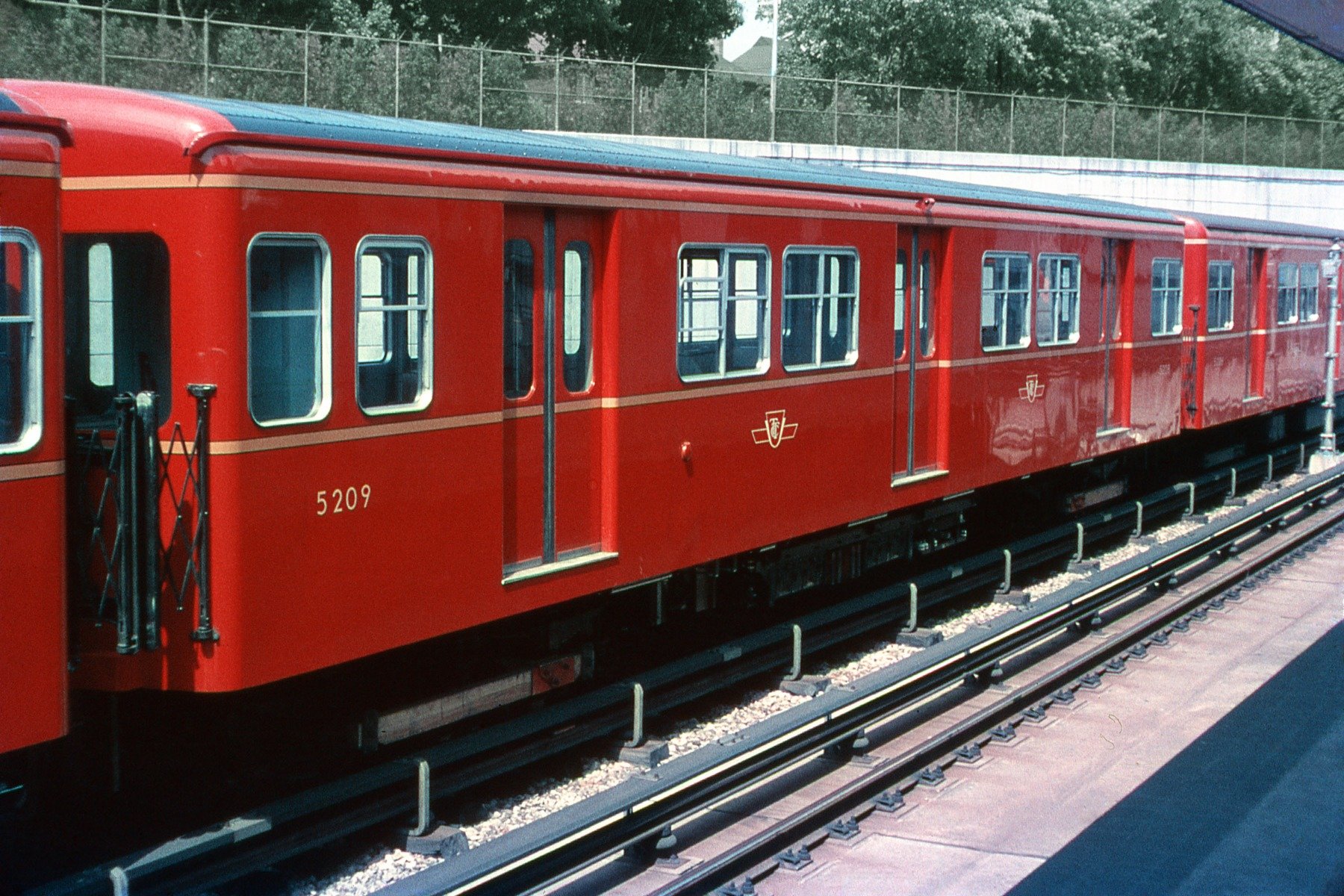
G-3 class car 5209 rests on the 2 North yard track beside the Davisville Station platform in August 1956. The G-3 class cars were inserted between the corresponding fleet numbers of the G-1 class so that 5208-5209 were between 5008 and 5009. William Vigrass photo, RL Collection.
The G cars offered a very comfortable passenger experience and operated very reliably on a daily basis from the start of subway operations until six cars were destroyed in a fire at Union Station on March 28, 1963. Passengers reported smoke in one of the cars as the train left Davisville Station. The situation could have been dealt with in the open cut section north of Bloor Station had the train stopped at Rosedale Station, however the operating protocols at the time did not require trains to stop immediately upon the discovery of smoke, so the train continued to Union Station and was parked in the centre track west of the platform, which made fighting the fire extremely difficult due to the narrow space around the train. Safety protocols were immediately enhanced following this event, which fortunately did not result in any injuries.
The cars provided dependable daily service throughout the rest of the 1960s and 1970s as the subway system expanded. In 1966-67 the experimental features were removed from the G-4 class cars and four of them were combined with G-1 class pairs. The two driving cars operated as a regular married pair. The fleet was fully overhauled between 1971 and 1973 and the livery was updated to a brighter shade of red paint with more vivid yellow stripes. As part of the overhaul, the bulky ventilation ductwork was removed, which reduced the weight of the cars, and new heaters were installed in the seat pedestals.
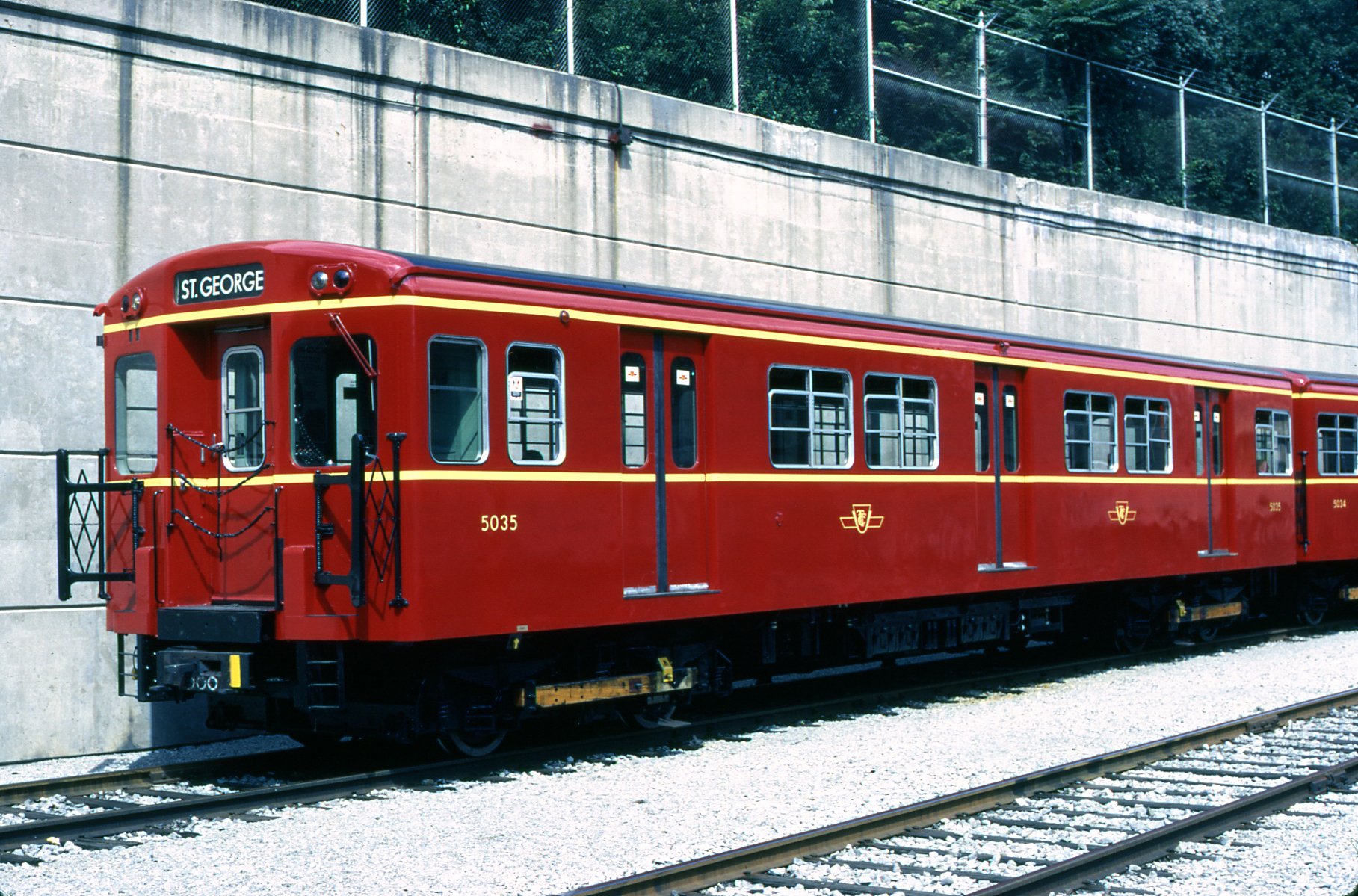
The first cars repainted in the updated “subway red” livery were 5032-5035. Fresh out of the paint shop, they were posed at Davisville on July 25, 1972. Edward A. Wickon photo, RL Collection.
1984 was the “Year of Celebration”, commemorating the 150th anniversary of the City of Toronto, a Bicentennial of the Province of Ontario, and the 30th anniversary of the Yonge Subway and the Toronto Transit Commission, which took over responsibility for all public transit within Metropolitan Toronto in 1954. As part of the celebrations, cars #5098-#5099 were repainted and decked out with “1984: A Year of Celebration” lettering on the sides of the cars and inside the advertising panels carried a pictorial exhibit of the history of the Yonge Subway.
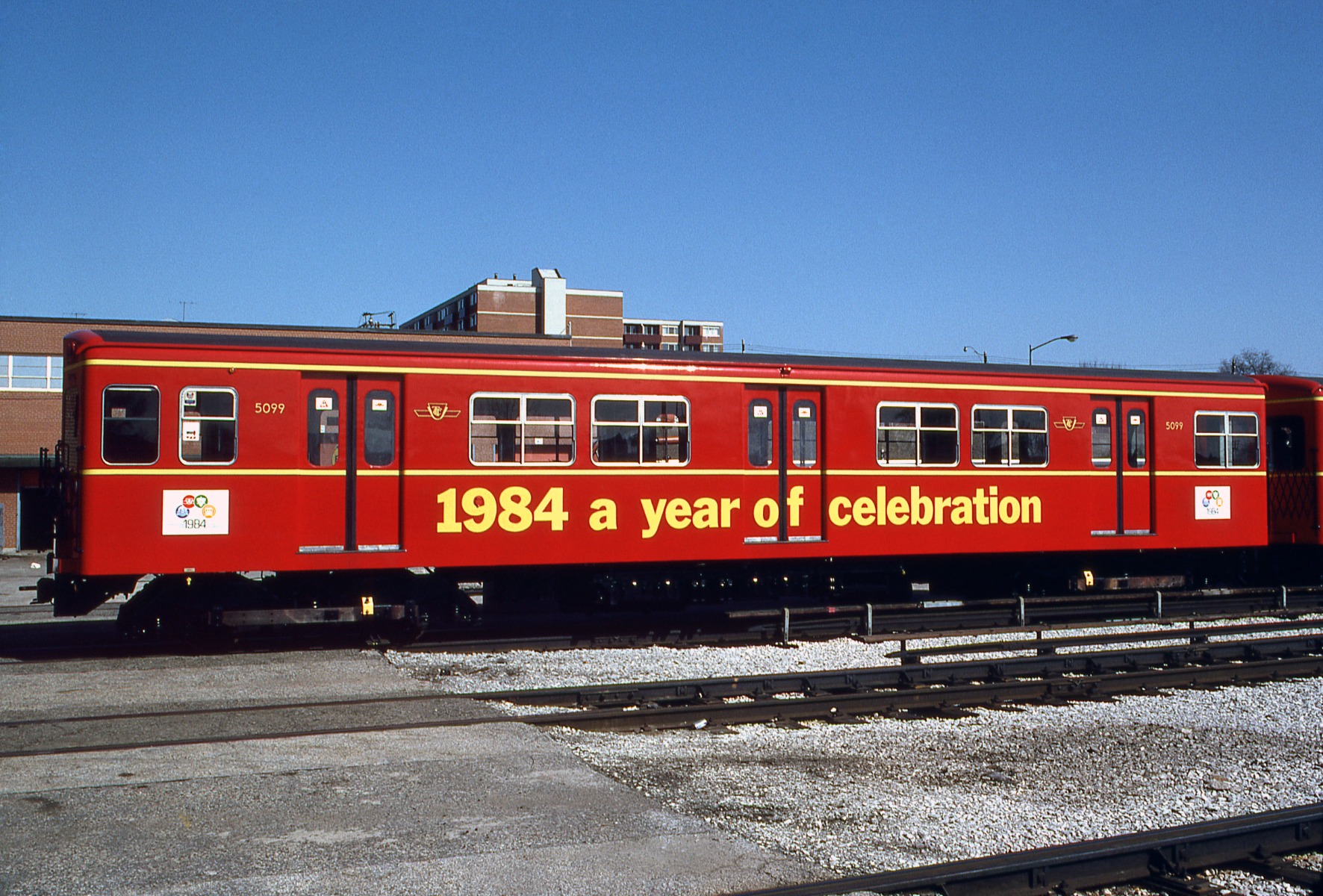
Cars 5098-5099 carried special lettering for the Year of Celebration in 1984. The cars were released from the paint shop in time for the Yonge Subway’s 30th anniversary on March 30, 1984. Edward A. Wickson photo, RL Collection.
The TTC finally considered retirement for the Gloucester fleet in the early 1980s. An order for 126 new cars to replace the G cars was expected to enter service beginning in 1986 however various circumstances resulted in a protracted delivery of these cars (the H-6 class), and numerous technical issues took them out of service frequently, which delayed the withdrawal of the G class cars. Retirement of the Gloucester cars eventually began in early 1988 and continued throughout 1989, with one last G train operating between October 1989 and October 26, 1990. The train did not operate in service on its last day and there was no fanfare or commemoration of the cars at their retirement.
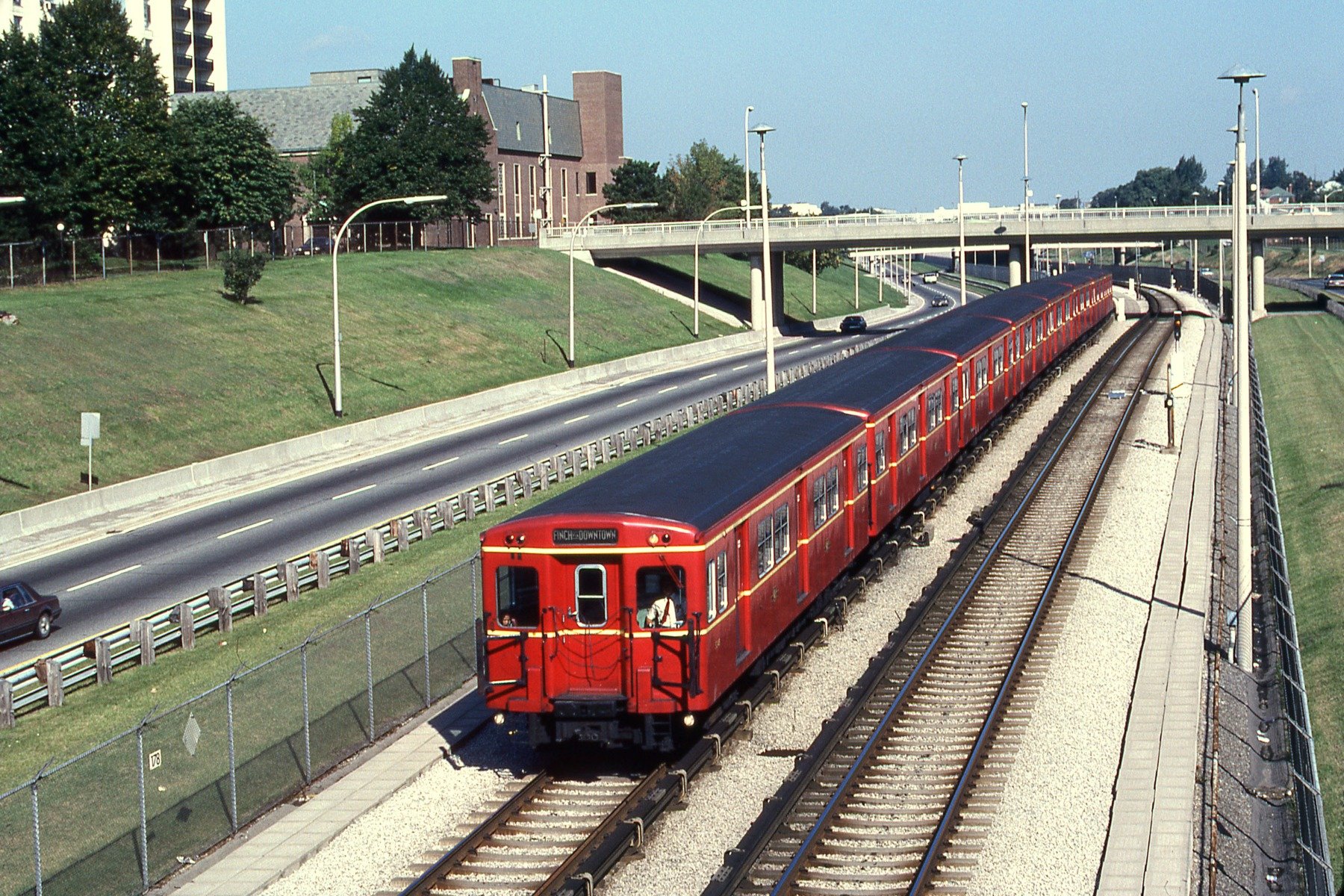
A G-class train operates southbound on the Spadina Subway near Elm Ridge Ave. on September 28, 1985. Robert D. McMann photo, RL Collection.
The cars were put up for sale as an operating fleet, and there was interest from Lima, Peru in acquiring them for a new metro system. This prospective deal fell through and the cars were cut up for scrap between November 1990 and April 1991. Eight cars had been converted to work trains (the six G-2 class cars and one pair of the G-1 class), and two cars were donated to the Ontario Electric Railway Historical Association, where they are on display at the Halton County Radial Railway museum in Milton, Ontario. The two cars at the museum, #5098 and #5099, were lead cars on the official train that opened the subway in 1954. The G class operated for a total of 36 and-a-half years with an enviable record of reliability. Despite their flaws, they were well-built to a high level of quality, which set the standard for subsequent subway car orders. They are generally fondly remembered by riders, although in hot weather newer air-conditioned trains were more appealing. They carried generations of Torontonians to work, school, shopping, hockey games and recreation and remain icons of Toronto transit history, along with the PCC streetcar and the New Look bus.
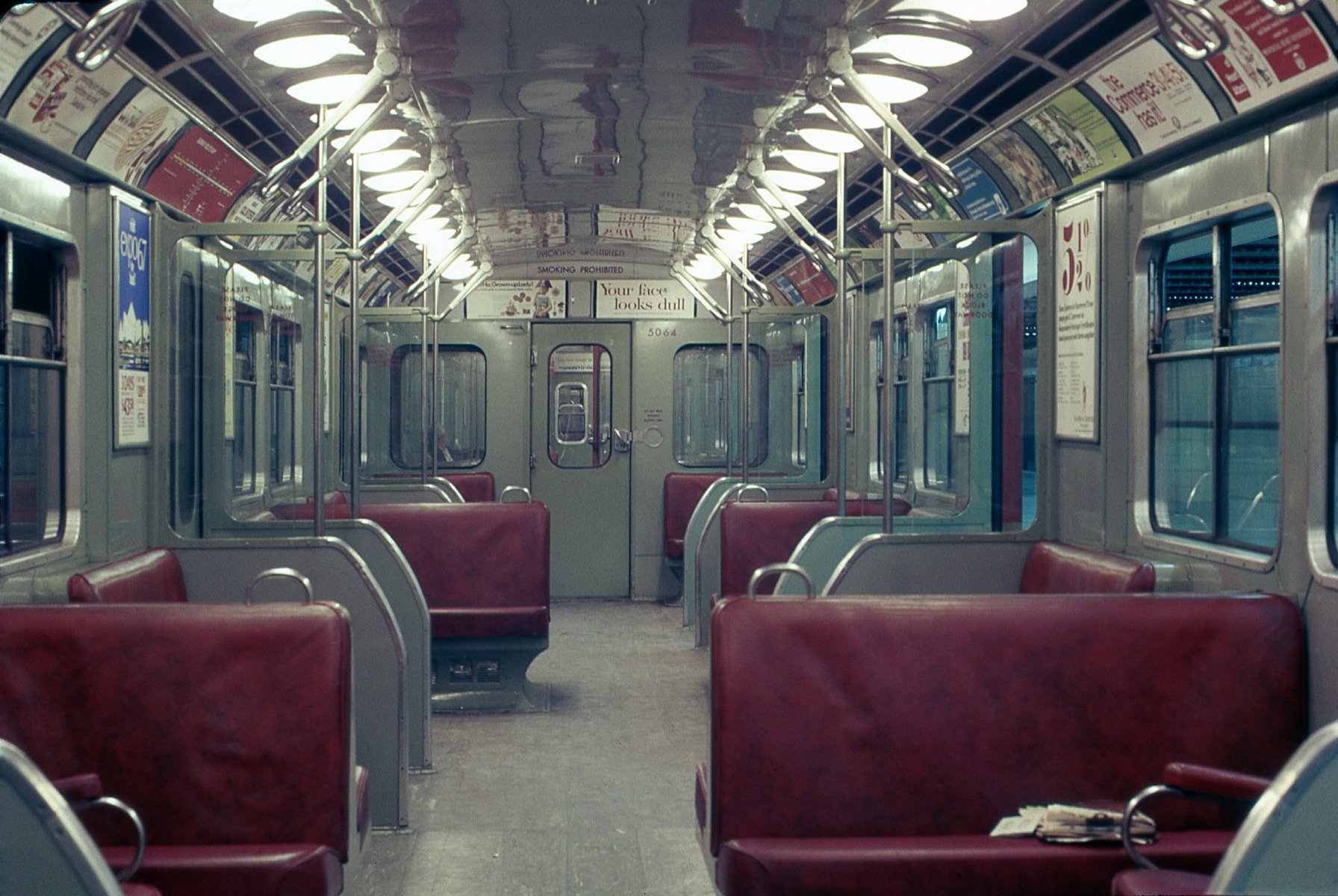
Interior of G-1 class car 5064 in August 1967, with the original ventilation louvres in the ceiling and seat pedestal grilles in place. The louvres were replaced with blank panels and the painted pedestals were replaced with stainless steel in the early 1970s overhaul.
G Class Roster
| Class | G-1 | G-2 | G-3 | G-4 |
| Fleet Number | 5000-5099 | 5100-5105 | 5200-5227 | 5110-5115 |
| Year Built | 1953-1954 | 1954-1955 | 1956 | 1958-1959 |
| Last Unit Retired | 1990 | 1988 | 1988 | 1990 |
| Seating | 62 | 62 | 62 | 62 |
| Length | 57’ 0.25” | 57’ 0.25” | 57’ 0.25” | 57’ 0.25” |
| Width | 11’ 3.375” | 11’ 3.375” | 11’ 3.375” | 11’ 3.375” |
| Height to top of Roof | 11’ 11.5” | 11’ 11.5” | 11’ 11.5” | 11’ 11.5” |
| Truck Wheelbase | 38’ | 38’ | 38’ | 38’ |
| Wheel Diameter | 30” | 30” | 30” | 30” |
| Weight (average of pair) | 83,328 lbs (1) | 73,452 lbs | 76,720 lbs | 82,776 lbs |


